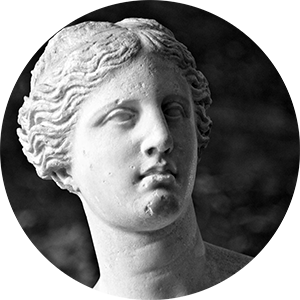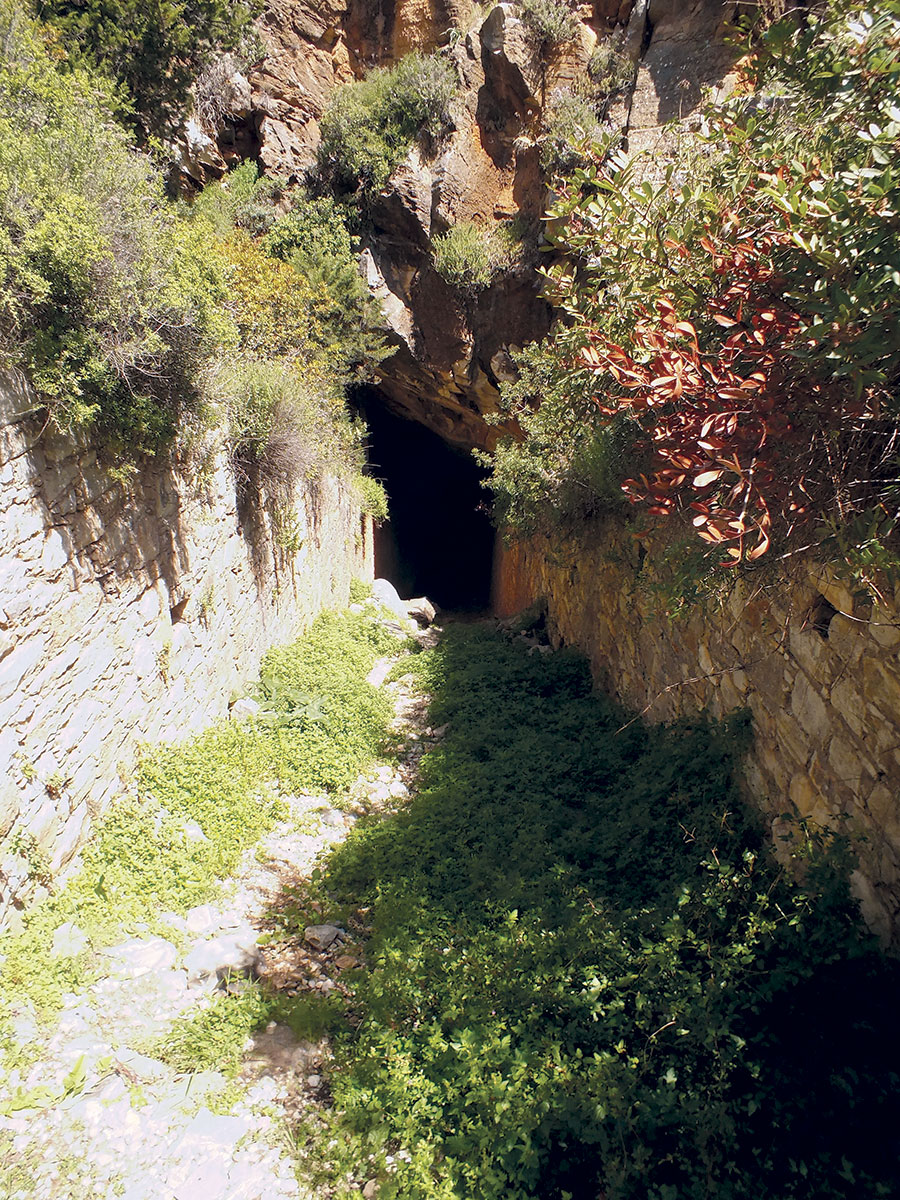Text and photos: Alexis Petidis, first published in PAROLA magazine
Secrets of the ancient quarries
Unlike the rather exaggerated marble paved road seeming to be leading nowhere, the whole quarry area gives an impression of abandonment. A uniquely exquisite exception, the modern marble sculptures found in the specially formed plateau near the ancient quarries. These sculptures were produced in situ by Greek artists who took part in the 1st Sculpture Symposium of Paros in the summer of 2011. *
“The island of Paros is a piece of marble emerging from amongst the waves of the Aegean Sea”, wrote Andre Bonnard, a French hellenist, a few decades ago, intending to stress the particular physiognomy of the island, derived from the famous Parian marble, a material which cast a spell on the artists of antiquity. It was the raw material out of which numerous masterpieces of ancient sculpture and architecture were made, such as Praxiteles’ Hermes, Aphrodite of Melos, Nike of Samothrace, Nike of Paeonios in Olympia, the sculptures of the Mausoleum in Halicarnassus and those of the Temple of Artemis in Ephesus.
Scores of marble quarries, most of them at surface level with a few underground ones, were opened over the centuries at various spots on the island, at Kostos, Naoussa, Thapsana, Horidaki, Dryos and so on. Among them, most distinguished are the underground ones in Marathi, about 5 kilometres from Paroikia. Their fame is not without reason, as they were home to the renowned “lyhnitis”, the best and rarest quality of Parian marble: white as snow, fine grain, exquisitely transparent, offering unprecedented plasticity to the sculptures, hence it was mainly used for statue making. There was also a “second” quality of white Parian marble, the so-called “white rock”. Thicker and less transparent, was mainly used for the construction of buildings and temples.
The quarries in Martathi extend on both sides of a valley formed by the Skarpathiotis, a stream that runs on the mountain slopes. Its waters digging into the soil, the stream revealed the “lyhnitis” to the ancient inhabitants of the island. Initially they would only quarry on the surface, but later, when the surface sources ran dry but demand was constantly increasing, ancient marble quarrymen followed the veins of marble under the ground, building tunnels and underground halls. It was an extremely tiring and difficult job. The quarrymen, skilled technicians, usually slaves but very often free men as well, worked with various types of hammers, round, square and pointed ones, extremely heavy ones, cutters, needles and a number of other tools. Facing a wall of marble, they used to follow the downhill direction of the veins and cleared the upper part of the material, thus creating a narrow roof allowing enough space for one worker lying sideways to dig. Next the sides and the back was freed, so that a huge square shaped volume of marble emerged from the ground. This was later detached from the rock using iron wedges placed around its base. In the darkness of the depths of the earth work was carried out with aid of torches, “lyhni”, which probably provided the rock with its name, “lyhnitis”.
Although the first use of Parian marble is recorded in the 4th millennium B. C., the Marathi underground quarries were opened in the 7th century B. C. Until the 5th century marble trade brought a great reputation, fame and wealth to Paros, which gradually decreased after the discovery of Pentelic marble in Athens, which was a lot easier to carry. Lyhnitis, nevertheless, never ceased to be in demand, but its exploitable deposits ran dry at around 300 B. C. Other qualities of marble, however, kept being in use until Roman times. After the 2nd century A. D. interest in the quarries withered and with very few exceptions the quarries remained inactive until the establishment of the modern Greek state.
After the war for independence in 1821, the industrial revolution arrived quite late in the newly born Greek state and, oddly enough, triggered an explosion of mining activity on the Greek islands. The first efforts made in Paros to re-activate the quarries in Marathi started in 1840, initially with the dreamer architect Stamatis Kleanthis, the first city planner of Athens, and were continued by a French company, but to no avail. In 1878 Belgian businessmen in collaboration with Greek land owners founded the Belgian Company of Parian Marble, which, in a unique effort, builds engine sheds, winch sheds, accommodation and offices near the quarries, a factory for marble cutting in Paroikia, a railroad with rock carrying wagons and buys a ship for transporting the marble! A new aisle is opened providing access to the ancient quarry, the existing one is widened, new tunnels are curved, in short the quarry is completely renovated. After having spent a fortune, about 5,800 000 francs, the company interrupts work in 1881 due to unreasonable expenditure and, consequently, it comes into Greek hands and starts operating under a new name, Greek Company of Parian Marbles. Essentially, however, the whole effort resulted in emptying the quarries of thousand cubic metres of pebble, stones and other small pieces left behind by ancient quarrymen, when filling up with useless materials the quarried spaces. When this enormous amount of material had been taken away, it was made clear that all useful quantities of lyhnitis had been already removed by the ancient quarrymen. So in 1884 the Greek Company of Parian Marbles went bankrupt. Minor efforts made later on had no better luck and the area was left in peace. Whatever quantities of lyhnitis are still there, must be lying at the very depths of Parian land…
A little further outside Marathi, a wide marble paved road starting at a turning of the Paroikia-Lefkes road, later turns into a soil path and takes us to the best known ancient quarry, the one on the eastern side of the valley. Two aisles link this quarry with the world outside. We first come to the northern one going down into the ground with well built walls, looking like the dwarf city in the Lord of the Rings. Its well preserved entrance is evident of its age: it’s the one opened in the 19th century to serve as a new way into the ancient quarry.
A bit further away a relatively spacious cave opens up under enormous masses of marble marking the spot of the second aisle leading to the quarry. It is the ancient entrance to it, verified by the hellenistic sculpture dedicated to the Nymphs dated back to 350 B.C. Carved on the left side of the rock, behind the railing which has been placed there to protect the cave from vandalism. The sculpture gave its name to the quarry, “The quarry of the Nymphs”.
The quarry of the Nymphs is 200 m long and 50-120 m wide. In ancient mines large square columns of rock were left to serve as roof support. In later times illegal quarrymen took away many of those columns resulting in the ceiling giving way. Moreover, the residues of quarrying activity fill up much of the inner space.
This is why access is not allowed and entrances are kept closed with metal fences.
However, an equally impressive and a lot more easily accessible underground quarry, the entrance of which has been restored allowing visitors to get in up to a certain point, can be found a few hundred metres away. A rather uneven dirt road leads there going uphill onto the western side of the valley toward the St. Minas monastery, amongst other older and newer quarries. A relevant sign at the entrance signposts its position. Marks from the tools of ancient quarrymen are visible on the ceiling and the sides and at other places graffiti engraved or painted in black paint reveal names of visitors and old foreign travellers. (It is advisable to carry a torch with you).
* In 2017 the sculptures were transferred from Marathi to different spots in Parikia.



